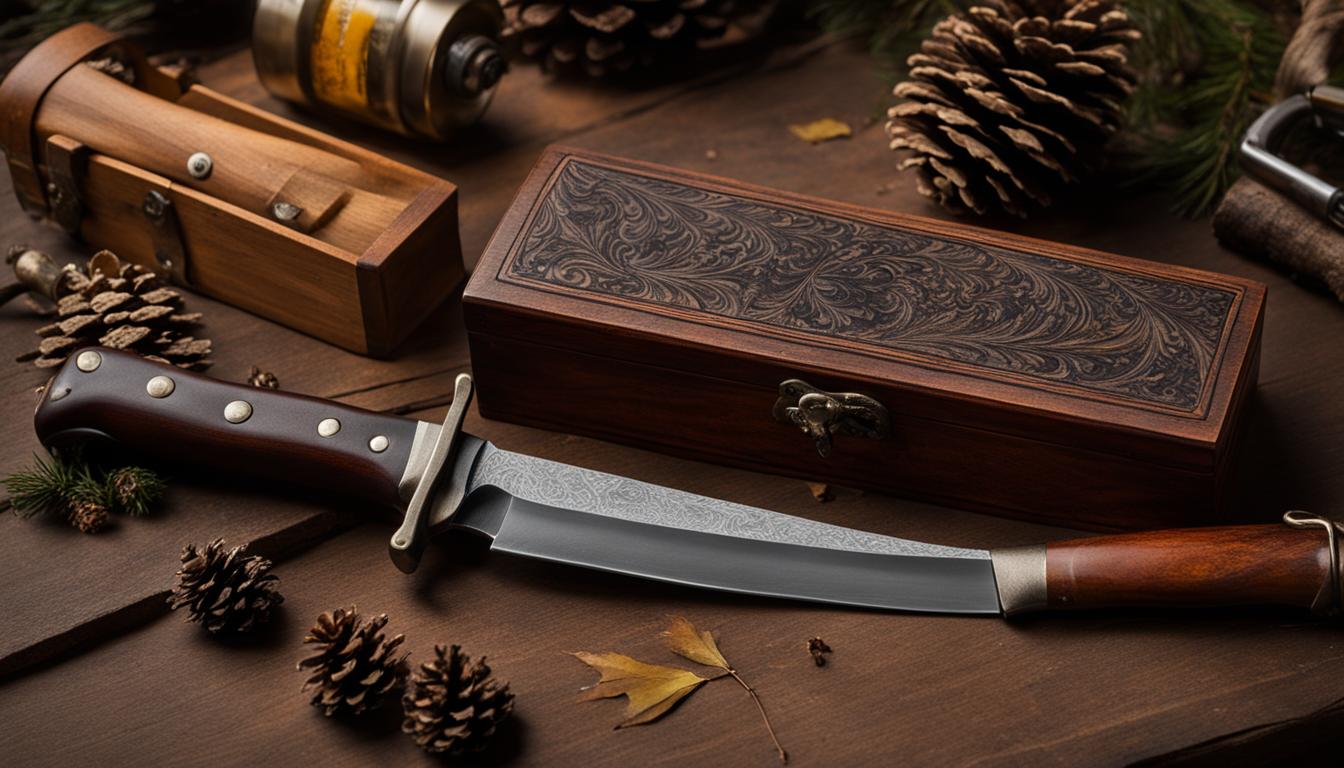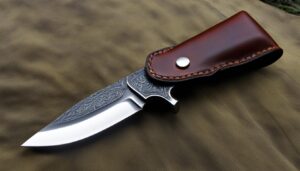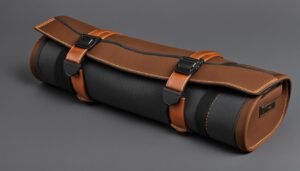Greetings, fellow hunting enthusiasts! In this comprehensive guide, I will provide you with valuable information and tips on how to properly store and maintain your hunting knives. As we all know, a sharp and well-maintained knife is essential for a successful hunting trip. So, let’s dive in and learn how to keep our trusty tools in optimal condition.
When it comes to hunting knife care, proper storage and maintenance are key. By following these guidelines, we can ensure that our knives are always ready for action in the field. Whether you’re a seasoned hunter or just starting out, these tips and techniques will help you keep your knives in top-notch shape.
Key Takeaways:
- Regularly clean your hunting knife using dish soap, warm water, and a soft brush.
- Dry your knife thoroughly after cleaning and apply a thin coating of oil to prevent rust and corrosion.
- Store your hunting knife in a dry, temperature-controlled environment to prevent damage.
- Consider using leather sheaths or wooden boxes for safe and secure storage.
- Regularly sharpen your hunting knife using sharpening stones or guided systems to maintain its performance.
By following these key takeaways, you can ensure that your hunting knives are always in optimal condition for your outdoor adventures. Remember, proper knife maintenance is not only crucial for performance but also for safety. Happy hunting!
Understanding Different Types of Hunting Knives for Proper Storage
When it comes to hunting knives, there are various types available, each designed for specific purposes. Understanding these different types is essential for proper storage and maintenance. Let’s explore some of the most common hunting knife types and the best storage solutions for each:
1. Skinning Knives
Skinning knives are designed with a thin, curved blade that makes them perfect for removing the skin from game animals. These knives require careful storage to maintain the sharpness of their blades. A recommended storage solution for skinning knives is a protective sheath made from durable materials like leather or nylon. The sheath will not only keep the blade safe from damage but also protect the user from accidental cuts.
2. Gut Hooks
Gut hooks are hunting knives featuring a small semi-circular hook on the spine of the blade. This specialized feature allows hunters to make precise incisions when field dressing game animals. To store gut hook knives, consider using a sheath with a built-in gut hook holder. This will ensure the hook remains protected and prevents accidental injuries when reaching for the knife.
3. Boning Knives
Boning knives are designed to separate meat from the bone with precision. These knives typically have a narrow, flexible blade that allows for easy maneuvering around joints and tight spaces. The best storage solution for boning knives is a knife block or magnetic knife strip. These options keep the blade safely stored while also providing quick and easy access when needed.
By understanding the different types of hunting knives and utilizing the appropriate storage solutions, hunters can ensure their knives remain in optimal condition for years to come.
https://www.youtube.com/watch?v=_iF_5yFmHPM
Proper Cleaning Techniques for Hunting Knives
Keeping your hunting knives clean is essential for their longevity and performance. Regular cleaning not only helps prevent rust and corrosion but also ensures that your knives are always ready for use. In this section, I will guide you through the step-by-step process of cleaning your hunting knives.
Before you begin, gather the necessary supplies: dish soap, warm water, a soft brush, and a clean rag. Start by rinsing your knife under warm running water to remove any dirt or debris. Be careful not to submerge the knife entirely as water can damage the handle or affect the blade’s integrity.
Next, apply a small amount of dish soap to the soft brush and gently scrub the blade, handle, and any other parts of the knife. Pay close attention to any hard-to-reach areas or stubborn stains. Rinse the knife thoroughly to remove any soap residue.
Once the knife is clean, dry it completely with a clean rag to prevent moisture from causing rust. Make sure to dry both the blade and the handle, paying extra attention to the crevices and joints. Finally, apply a thin coating of oil to the blade to protect it from oxidation. You can use specialized knife oil or even mineral oil as a substitute.
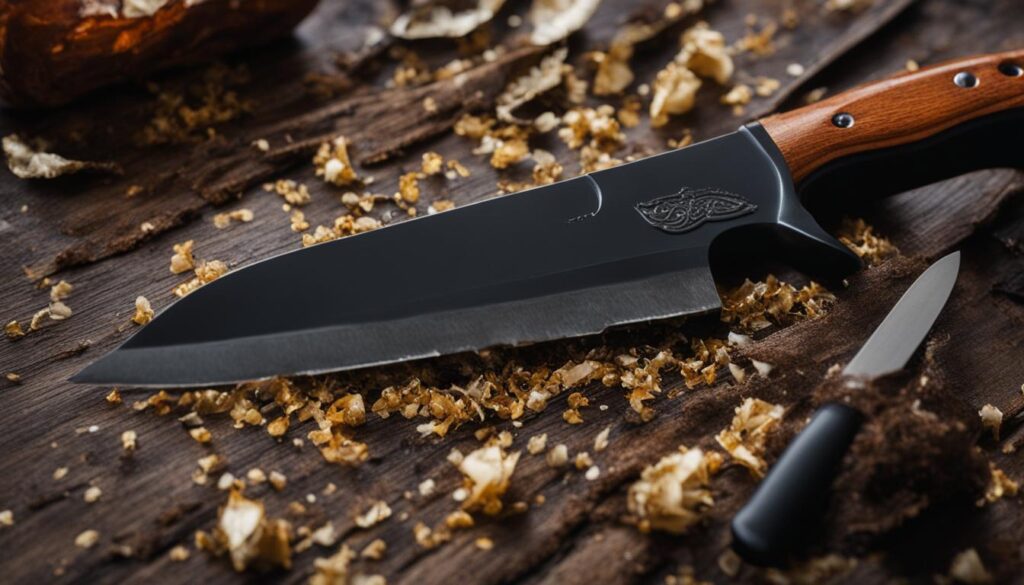
Remember to clean your hunting knives after each use, especially if they have come into contact with blood, dirt, or moisture. Regular cleaning and maintenance will not only extend the lifespan of your knives but also ensure they are safe and efficient during your hunting adventures.
Storing Hunting Knives to Prevent Damage
Properly storing hunting knives is essential to prevent damage and maintain their longevity. Whether you’re a seasoned hunter or just getting started, here are some valuable knife storage tips to keep your blades in optimal condition.
1. Choose the Right Storage Environment
The first step in proper knife storage is to select the right environment. It’s crucial to store your hunting knives in a dry and temperature-controlled area to prevent moisture and humidity from causing rust or corrosion. Avoid storing them in basements, garages, or other areas prone to temperature fluctuations.
2. Consider Storage Options
Investing in suitable storage options can further protect your hunting knives from potential damage. Leather sheaths are a popular choice as they provide a secure and protective covering. Wooden boxes with soft linings can also be used to store multiple knives, keeping them organized and safe from scratches or accidental knocks.
3. Protect the Blades and Handles
Dent and scratch-resistant blade protectors or guards can be used to shield your knife blades during storage. They help prevent accidental contact with other objects and minimize the risk of nicks or chips. Additionally, applying a thin coat of oil to the blades before storage can help prevent rust formation.
By following these knife storage tips, you can ensure that your hunting knives remain in excellent condition and ready for your next outdoor adventure.
| Storage Tip | Description |
|---|---|
| Avoid Moisture | Store knives in a dry environment to prevent rust and corrosion. |
| Use Protective Sheaths | Invest in leather sheaths or sheath covers to protect the blades from scratches and accidental damage. |
| Consider Wooden Boxes | Wooden storage boxes with soft linings can keep multiple knives organized and safe from impacts. |
| Apply Blade Oil | Coat the blades with a thin layer of oil to prevent rust formation during storage. |
Sharpening Techniques for Hunting Knives
Keeping your hunting knives sharp is crucial for maintaining their performance and ensuring that they are always ready for use in the field. In this section, we will explore different sharpening techniques that you can use to maintain the sharpness of your hunting knives.
Using Sharpening Stones
One of the most common methods for sharpening hunting knives is using sharpening stones. Start by wetting the stone with water or oil, depending on the type of stone you are using. Hold the knife at a 20-degree angle and move it across the stone in a sweeping motion, applying consistent pressure. Repeat this process on both sides of the blade until you achieve the desired sharpness. Remember to regularly clean the stone to remove metal shavings and keep it in good condition.
Using Guided Systems
Another popular option for sharpening hunting knives is using guided systems. These systems typically consist of a clamp or guide that holds the knife at the correct angle while you run it along a sharpening surface. Guided systems provide more stability and ensure consistent results. Follow the manufacturer’s instructions for your specific guided system to achieve optimal sharpening.
Regardless of the sharpening technique you choose, always remember to take your time and be mindful of safety. Keep your fingers away from the blade and use proper safety equipment, such as cut-resistant gloves, when necessary.
| Sharpening Technique | Pros | Cons |
|---|---|---|
| Sharpening Stones | Allows for precision sharpening, suitable for all types of knives | Requires practice and skill to achieve consistent results |
| Guided Systems | Provides stability and ensures consistent results | May require an initial investment and additional equipment |
Remember, regular maintenance is key to keeping your hunting knives sharp. Make it a habit to regularly inspect and sharpen your knives to ensure they are always in optimal condition for your outdoor adventures.
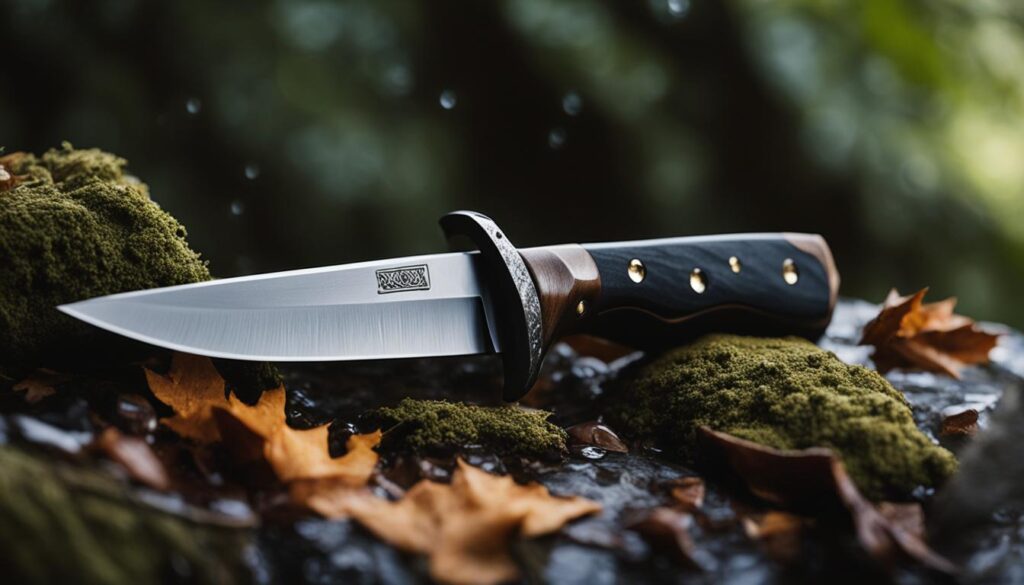

Conclusion
In conclusion, this comprehensive guide serves as a valuable hunting knife maintenance guide, providing hunting enthusiasts with essential information on proper storage and maintenance. By following the guidelines outlined in this guide, you can ensure that your hunting knives remain in optimal condition for your outdoor adventures.
Throughout this guide, we have covered various topics, including cleaning techniques, storage solutions, and sharpening tips. Cleaning is a crucial part of knife maintenance, and we have provided step-by-step instructions on how to clean your hunting knives effectively. Remember to dry the knives thoroughly and apply a thin coating of oil to prevent rust and corrosion.
Proper storage is also key to preventing damage to your hunting knives. We have discussed the importance of storing knives in a dry, temperature-controlled environment and have offered suggestions such as leather sheaths or wooden boxes. Additionally, we have provided tips on protecting the knife blades and handles during storage.
Lastly, maintaining the sharpness of your hunting knives is essential for optimal performance. We have explained various sharpening techniques, including the use of sharpening stones or guided systems. By regularly sharpening your knives and following our guidelines, you can ensure that the blades remain sharp and ready for use.
In conclusion, by prioritizing proper storage and maintenance, you can prolong the lifespan of your hunting knives and ensure that they are always in optimal condition. Remember to always prioritize safety and adhere to local laws and regulations when handling and using hunting knives. Thank you for reading this guide, and happy hunting!
FAQ
How often should I clean my hunting knife?
It is recommended to clean your hunting knife after each use to prevent dirt and debris from building up and causing damage to the blade.
What is the best way to dry my hunting knife after cleaning?
After cleaning, make sure to thoroughly dry your hunting knife using a soft cloth or towel. You can also use compressed air to remove any moisture from hard-to-reach areas.
How often should I apply oil to my hunting knife?
It is recommended to apply a thin coating of oil to your hunting knife after cleaning and drying it. This helps to prevent rust and corrosion and keeps the blade in optimal condition.
Can I store my hunting knife in a leather sheath?
Yes, storing your hunting knife in a leather sheath is a good option as it protects the blade and provides a secure storage solution. Just make sure the sheath is clean and dry before storing the knife.
Should I store my hunting knife in a wooden box?
Storing your hunting knife in a wooden box is a great way to protect it from dust and moisture. Just ensure that the box is dry and lined with a soft material to prevent scratches on the blade.
How often should I sharpen my hunting knife?
The frequency of sharpening your hunting knife depends on how often you use it. As a general guideline, it’s recommended to sharpen the blade when you notice a decrease in its cutting performance.
What is the best sharpening technique for hunting knives?
There are different sharpening techniques for hunting knives, but using sharpening stones or guided systems is highly recommended. These methods help maintain the proper angle and ensure a sharp edge.
Are there any safety considerations when handling hunting knives?
Yes, safety should always be a priority when handling hunting knives. Always follow local laws and regulations regarding the use and storage of knives. Handle them with care, use protective gloves if needed, and keep them out of reach of children.
